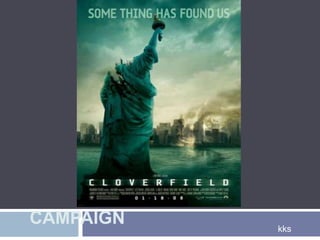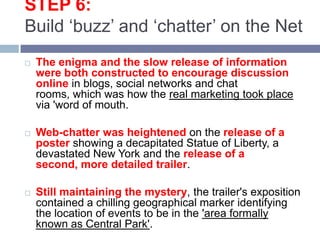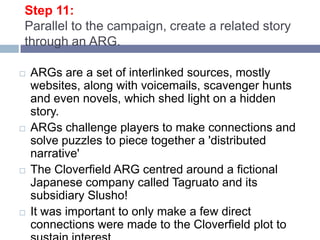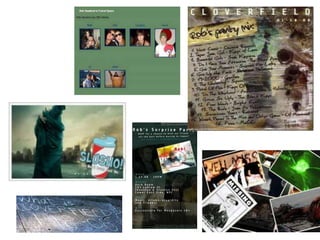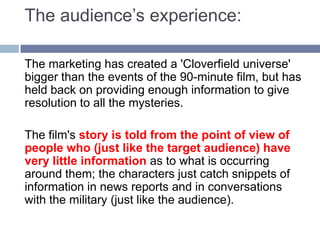Hollywood marketing
- 2. Budget Cloverfield had a very low production budget in Hollywood terms: £15mBut it became an instant financial success making £22m in its opening weekend!How did they do it?
- 3. Step 1Having a very specific target audienceThe director (Matt Reeves) called the film 'a monster movie for the YouTube generation' indicating that the producers of this film were specifically aware that their target audience were Internet-literate young people. They knew they would have to make use of recent developments in technology not only to entice them BUT encourage them to actually be a part of it!
- 4. Step 2The first glimpse – have a fantastic Teaser Trailer When would it be shown?Importance of placement: the teaser trailer shown before the 2007 summer blockbuster, Transformers. What should be revealed?The trailer did not name the filmIt only gave a release date after showing glimpses of an apparently home-made video of New York being attacked by somethingIts final image was the shocking: the head of the Statue of Liberty crashing through a New York street. The filmmakers used enigma codes to generate curiosity e.g:What genre was the film alluding to (Sci-Fi/Disaster/Monster)? Why was the footage they had been shown more like their own home-movies rather than a slick Hollywood production?
- 5. Step 3:A techno-savvy audience needs a matching marketing campaign:The film:Use of alternative reality games and videocam techniques involve audiences in new and interactive ways.The marketing had to match and produced a viral marketing campaign: an enigmatic teaser-trailerword of moutha widget.
- 6. Step 4: Drip feed information to generate curiosityThe teaser trailer only provided one piece of important information: the name of the producer JJ Abrams. This would have created a number of genre expectations: Abrams is the creator of ‘Alias’ and ‘Lost’ and so the audience could expect an element of Sci-Fi/Horror within this film and might anticipate a narrative that was complex, fragmented and laden with 'clues' rather than explanations.
- 7. Step 5: Restrict InformationWeb searches after the teaser trailer led the audience to a website named only as the date of the film's release (www.1-08-08.com). This site slowly released photos which were time and date stamped to allow the audience to build up chronological glimpses into the narrative of the film.
- 8. STEP 6:Build ‘buzz’ and ‘chatter’ on the Net The enigma and the slow release of information were both constructed to encourage discussion online in blogs, social networks and chat rooms, which was how the real marketing took place via 'word of mouth. Web-chatter was heightened on the release of a poster showing a decapitated Statue of Liberty, a devastated New York and the release of a second, more detailed trailer. Still maintaining the mystery, the trailer's exposition contained a chilling geographical marker identifying the location of events to be in the 'area formally known as Central Park'.
- 10. STEP 7:Set up an official websiteFor the first time the film's title was identified and the trailer was released online along with an official movie website (www.cloverfieldmovie.com)
- 11. STEP 8: Create a virtual worldThe website provided links to MySpace and Facebook pages 'created' by some of the characters from the film. These regularly updated pages created a real-time story which showed the characters moving towards the eventful night and provided a back-story to the film itself. The MySpace blog was used for key narrative information e.g. the film's protagonist announces he was moving to Japan to take a new job at Slusho!, a Japanese soft drinks company, which explains why the film begins with a going away party.
- 12. Step 9:Create a widget available for download This piece of software could be attached to MySpace pages, blogs etc. and contained the first five minutes of the film with an introduction by JJ Abrams. To download and use the widget people needed to register their contact details. This registration immediately entered people into a competition based on who managed to distribute the widget to the most people; a direct encouragement of more 'word of mouth' marketing.
- 13. STEP 10: Do the traditional stuff too For e.g.Adverts were also sent to mobile phonesTraditional posters TV slots were also usedTo increase public and mainstream press awareness of the film. BUT:The campaign was created a deep curiosity as so much information had been held back and the only way for the audience to gain answers to the questions the marketing raised was to go to the cinema to see the film.
- 15. Step 11:Parallel to the campaign, create a related story through an ARG. ARGs are a set of interlinked sources, mostly websites, along with voicemails, scavenger hunts and even novels, which shed light on a hidden story. ARGs challenge players to make connections and solve puzzles to piece together a 'distributed narrative' The Cloverfield ARG centred around a fictional Japanese company called Tagruato and its subsidiary Slusho! It was important to only make a few direct connections were made to the Cloverfield plot to sustain interest.
- 17. So:Home pages for Slusho! and Tagruato were put online. Slusho! (the company the character Rob from the film was taking a job with) ran a competition for audience members to create adverts for the frozen soft drink whose USP was its addictive nature ('You can't drink just six') and the happiness it would bring its consumer: http://www.slusho.jp/ Vocab –Tagruato's corporate homepage looked like a conventional business website even down to experiencing hacks by 'eco-terrorists' It appeared that Slusho's key ingredient, 'seabed nectar', might not be entirely safe. The site reported that a drilling rig in the Atlantic Ocean had been mysteriously destroyed. 'TV reports' based on mobile phone footage showed huge chunks of debris being hurled from the sinking rig although there was no explanation for this phenomenon. Pictures from the scene were added to www.1-01-08.com.
- 18. Step 12:Create another thread on the websiteA number of back stories were created to encourage the audience to attempt to build a story for themselves; first of all to attempt to make sense of the promotional material and, after watching the film, to supplement the limited information provided by the film's highly restricted narration. For eg: an Manhattan couple Jamie and Teddy, were created to set up a website to post video-blogs to stay in touch after Teddy had gone to Japan to work for Tagruato. Eagle-eyed viewers could glimpse Jamie passed out on the sofa at Rob's leaving do in the opening scene of the film.
- 19. The audience’s experience:The marketing has created a 'Cloverfield universe' bigger than the events of the 90-minute film, but has held back on providing enough information to give resolution to all the mysteries. The film's story is told from the point of view of people who (just like the target audience) have very little information as to what is occurring around them; the characters just catch snippets of information in news reports and in conversations with the military (just like the audience).
- 20. Conclusion:The desire to make sense of the events unfolding within the film has been played on for both the interactive and mainstream audience but the filmmakers are still holding back vital pieces of information: What does Slusho! have to do with all of this? Where did the monster come from? Do the military manage to destroy the monster? Do any of the characters from the film survive? Could the actual film Cloverfield be just another element in a complex marketing campaign? Is the film an expensive advert for yet another product still to be made? There are online rumours already about a Cloverfield 2 with theories ranging from the sequel being told from another victim's perspective (plenty of people can be seen filming events in the film) or from a military or reporter's point of view. Maybe Cloverfield 2 will be a standard blockbuster movie with omniscient narration and a solid resolution. At this point the 'truth' is irrelevant. What is important is that people are talking about a potential second film and so the viral campaign has already begun!
- 22. Your task:Produce a Step-by-Step guide to the Marketing Campaign of your chosen Hollywood film.
